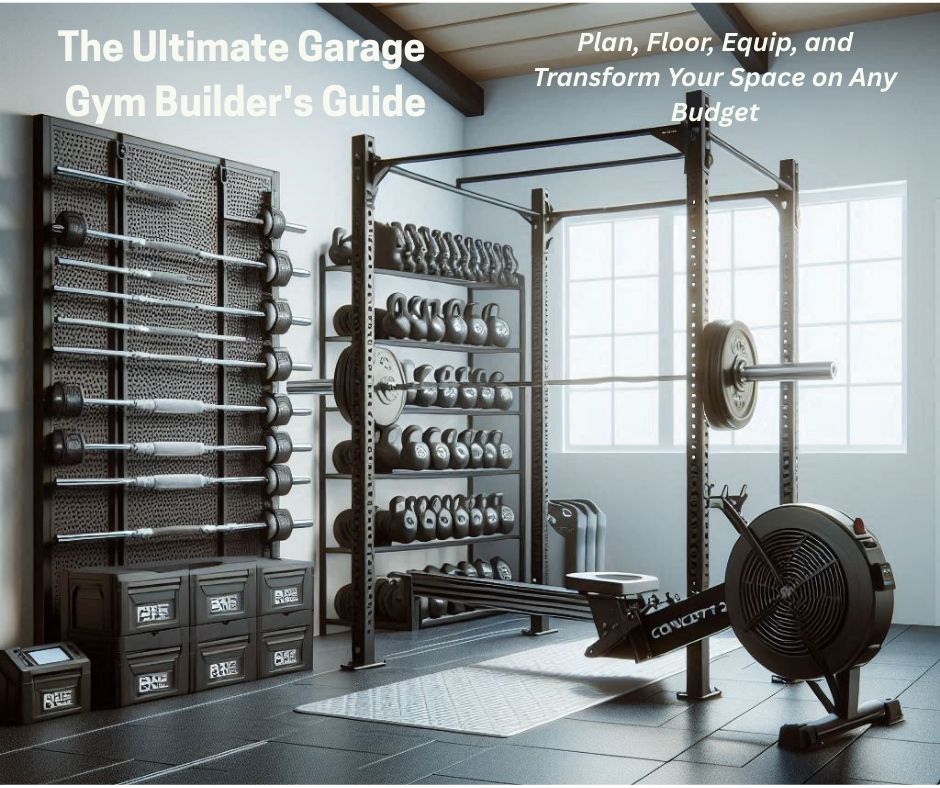Claim Your Space, Forge Your Strength
The garage: it’s more than a place to park your car or store holiday decorations. For fitness enthusiasts, it represents the ultimate blank canvas—a private, dedicated space to build something powerful. Creating a garage gym is the pinnacle of the home fitness journey, offering freedom, flexibility, and the room to grow that a spare bedroom corner simply can’t.
But transforming a cold, concrete space into a personal training sanctuary can feel daunting. Where do you start? What flooring do you need? How do you choose between a power rack and a squat stand?
This guide is your master blueprint. We’ll walk you through the entire process, from initial planning and critical prep work to selecting the right equipment for every budget and goal. Let’s turn your garage into the most effective gym you’ve ever been to.

Phase 1: The Blueprint – Planning Your Layout
Before you buy a single weight, you need a plan. A well-thought-out layout is the foundation of a safe and efficient gym.
- Measure Everything: Get the exact dimensions of your garage. Note the location of doors, windows, electrical outlets, and any obstructions. Don’t forget to measure ceiling height, especially if you plan on doing overhead lifts or installing a pull-up bar.
- Define Your Zones: mentally divide your space into dedicated areas. A typical effective layout includes:
- Strength Zone: For your power rack, barbell, and weight plates. This is your primary area.
- Cardio/Functional Zone: For a rower, bike, or a clear space for battle ropes, sled pushes, and plyometrics.
- Dumbbell & accessory Zone: For your adjustable dumbbells, kettlebells, and weight bench.
- Plan for Storage: Clutter is the enemy of a good workout. Wall-mounted storage is your best friend. Plan for:
- Weight plate storage (a tree or wall pegs)
- Barbell storage (vertical or horizontal racks)
- Shelving or cabinets for bands, straps, and accessories
Phase 2: The Foundation – Flooring and Environment
This is the most important—and often overlooked—step. Proper flooring protects your equipment, your floor, and most importantly, you.
- The Problem with Concrete: It is brutally hard on your joints and will destroy any equipment dropped on it. It’s also cold and can be damp.
- The Solution: Interlocking Stall Mats. These 4’x6′, 3/4″-thick rubber mats are the gold standard for garage gym flooring. They are incredibly durable, provide excellent shock absorption, and are far more affordable than custom-cut rubber flooring. Find them at farm supply stores like Tractor Supply Co.
- Installation Tips: Clean your garage floor thoroughly before laying down the mats. You can arrange them in a full-room layout or create specific lifting platforms in your designated strength zones.
Phase 3: The Equipment – Building Your Arsenal
This is the fun part. We’ll break this down by budget level, from essential starter kits to dream setups.
The Budget-Conscious Starter Pack ($500 – $1,500)
This setup focuses on maximum versatility with minimal investment.
- Adjustable Dumbbells: The cornerstone. A good set like Powerblocks or a Bowflex SelectTech replaces an entire rack of dumbbells.
- FID Bench (Flat, Incline, Decline): A must for pressing movements. A Rep Fitness AB-3100 or similar foldable bench offers great value.
- Resistance Bands: A full set for warm-ups, assistance work, and adding resistance to bodyweight exercises.
- Yoga Mat & Stability Ball: For core work, stretching, and mobility.
The Intermediate Lifter’s Sanctuary ($1,500 – $4,000)
This is where you can build a truly comprehensive strength training setup.
- A Power Rack or Squat Stand with Safeties: This is the heart of the gym. A power rack (like those from Rogue Fitness or Rep Fitness) allows for safe solo lifting with pull-up bars and attachment options. It’s non-negotiable for heavy barbell training.
- An Olympic Barbell & Weight Plates: The standard for strength training. Start with a good quality 20kg Olympic barbell and at least 200-300 lbs of bumper plates or cast iron plates.
- The Starter Pack Items: You’ll still use your dumbbells, bench, and bands constantly.
The Elite-Level Dream Gym ($4,000+)
This tier is for expanding into specialty equipment and filling out every possible training need.
- Cardio Equipment: A concept2 Rower or BikeErg for elite-level conditioning.
- Specialty Bars: A trap bar for deadlifts, a Swiss bar for pressing, and a curl bar for arm isolation.
- Leg Press/Hack Squat Machine: For overloading the legs without taxing the spine.
- Cable Machine/Functional Trainer: The ultimate accessory tool for lat pulldowns, cable flyes, and hundreds of other exercises. A wall-mounted pulley system is a great space-saving option.
Phase 4: The Finishing Touches
- Lighting: Replace dim garage lights with bright LED shop lights. Good lighting is crucial for safety and motivation.
- Ventilation: A fan or portable heater/AC unit will make your gym usable year-round.
- Atmosphere: A Bluetooth speaker, a whiteboard for tracking workouts, and maybe even a TV can make the space more enjoyable.
Conclusion: Your Journey Begins Now
Building a garage gym is a rewarding project that pays dividends in health, convenience, and strength for years to come. Start with a solid plan, invest in your foundation (literally, with good flooring), and build your equipment collection strategically based on your budget and goals.
Remember, the best gym is the one you actually use. By creating a space that is organized, safe, and tailored to your preferences, you’ve removed every barrier between you and your next great workout.
